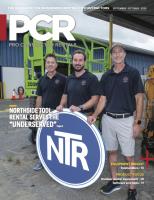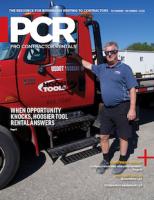Service Tips: Five misconceptions about lithium-ion power
Vanguard battery experts bust myths about today’s Li-ion battery technology.
Li-ion has been a household name for some time now, powering computers, smartphones and even toothbrushes.
Only in recent years has the technology been widely embraced by the construction industry to power a variety of equipment on job sites across the world.
Li-ion batteries are safer, stronger and more durable than ever. As the construction industry is increasingly embraces electrification, there are some lingering misconceptions about the power source. Vanguard battery experts outline these myths and share the facts about this power source and how to keep equipment and tools running at maximum capacity and prolong battery system life.
MISCONCEPTION 1: Battery-powered equipment can’t handle the elements.
In today’s busy world, there is no “construction season.” Work happens in extreme heat and frigid cold. Somewhere along the way, a myth developed that battery-powered equipment isn’t rugged or durable enough to withstand the harsh conditions of a job site.
The reality: It’s true excessive heat and cold, as well as strong vibrations and exposure to moisture, can be disruptive to battery power. However, today’s battery solutions are built tougher and tested under the most severe elements to ensure they can deliver powerful, consistent performance, whatever the weather brings.
“Vanguard engineers design its Li-ion batteries knowing they are going into harsh environments,” says Nick Moore, director of sales electrification, Briggs & Stratton. “Being a company that has been selling engines for 100 years, we know a lot of the abuse that people tend to put equipment through. So, we are designing a battery capable of withstanding those factors.”
Vanguard customers are constantly pushing the envelope when it comes to taking tools and equipment to uncharted territory. Argo ATVs, for example, designs products that can swim across water, go through the mud and drive over logs.
“Argo came to Vanguard with the request for a Li-ion battery that could stand up to the rigorous environments in which its vehicles operate,” says Dave Schulenberg, director of product management, Briggs & Stratton. “We saw an opportunity to develop a battery that would meet Argo’s high standards and simultaneously field-test our battery’s rigorous performance capabilities.”
MISCONCEPTION 2: Battery power can be unpredictable.
Because electrification is relatively new in the off-road equipment industry, there is a tendency to assume it’s safer or more predictable to go with traditional fuel-powered machines. Downtime cuts into the bottom line, so contractors want to eliminate factors that may negatively impact their productivity.
The reality: Today’s Li-ion batteries offer loads of data and insights that keep the battery, and in turn the equipment, functioning at its best. These battery management systems (BMS) serve as an onboard computer that constantly measures the state of the battery. The BMS monitors and measures information such as the pack’s temperature, charge/discharge currents and voltages of each cell bank.
“Battery management systems help users make the proper decisions to use the battery safely and get the most performance out of it,” says Schulenberg. “If something is out of whack, the piece of equipment isn’t going to shut down without helping you know why. The system will help a user figure out exactly what the issue is so they can get back to work as quickly as possible.” Vanguard Li-ion batteries also feature internal contactors, which means when the equipment is off, the battery is off.
“That’s fairly unique on a battery, but it’s critical for customer safety,” says Moore. “When maintenance needs to be performed, having the ability to completely shut off all the power to the equipment is a crucial feature.”
MISCONCEPTION #3: If the battery dies, you are out of luck.
Another reason equipment users may shy away from battery power is the fear that work must stop if a battery is low on charge. There’s a notion that fuel power is better because users can easily put more gas in the tank.
The reality: It’s simple and quick to swap out the Li-ion power source. Briggs & Stratton recently introduced the Vanguard Lithium-Ion 1.5kWh swappable battery pack.
“The battery features an exchangeable design allowing customers to easily remove and replace the battery as needed with minimal downtime,” says Schulenberg. “OEMs can combine multiple swappable batteries in parallel to make sure larger power needs can be met.”
Vanguard customers often note how easily Li-ion batteries integrate into their equipment, making it simple to add electrification to their equipment lineup without having to worry much about servicing or maintenance needs.
“We’ve been told that we’ve made it very simple for OEMs to integrate Vanguard Li-ion batteries. They only have to follow the Vanguard installation guide and they’re up and running,” says Moore.
MISCONCEPTION #4: There’s only one way to charge a battery.
When it comes to charging battery-powered equipment, Users usually think they just plug it into its charging source and call it a day.
The reality: Instead, there are many factors that play into a proper charging strategy for a Li-ion battery.
Battery life can be impacted by several factors; prolonged exposure to heat or cold as well as charging for too long or short of time are among the main culprits. Adopting proper techniques when charging Li-ion powered equipment can go a long way in protecting the longevity of the power source and the equipment.
A BMS is a great tool to ensure charging hygiene. For example, the Vanguard BMS system will not allow users to charge the battery at too high or too low of a temperature, thus preventing any unintentional damage to the battery cells. It also helps prevent users from overcharging the battery.
MISCONCEPTION #5: Lithium-Ion batteries aren’t recyclable.
There’s a myth out there that Li-ion batteries are not recyclable. This is rooted in the legacy of an old battery type – nickel-cadmium (Ni-Cd) batteries – which are extremely difficult to dispose of at the end of their life cycle. Those kinds of batteries have since been entirely phased out.
The reality: “Li-ion batteries are incredibly recyclable,” says Moore. “The general public doesn’t realize that Li-ion batteries are different from those old batteries. They don’t have heavy metals in them that you have to worry about getting in your water supply.”
Li-ion batteries have a second life in them, meaning at the end of their life cycle, there is still about 80 percent of the battery capacity left. These batteries can then be repurposed in other applications.
The bottom line
When the misconceptions around Li-ion batteries are stripped away, end users are left with a reliable, rugged and sustainable power source that is helping OEMs meet their electrification goals while delivering on their customers’ ever-evolving power application needs.
This article originally appeared in the January-February 2022 issue of Pro Contractor Rentals magazine, ©2022 Urbain Communications LLC. All rights reserved.










